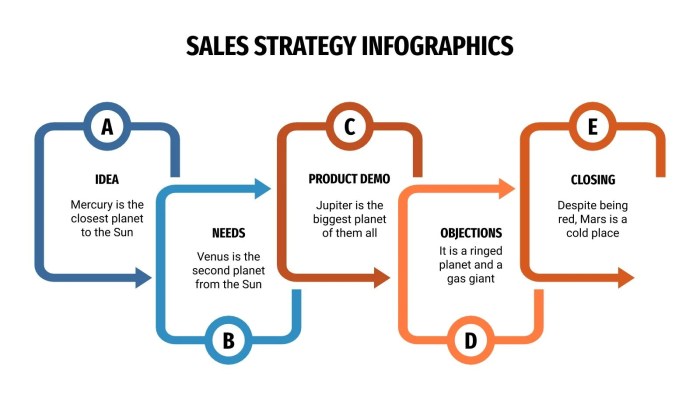Developing Sales Strategies takes center stage as we dive into the dynamic world of effective sales planning and execution, where success is the ultimate goal. From understanding market dynamics to setting achievable goals, this topic covers it all in style.
Get ready to explore the ins and outs of crafting strategies that drive sales and propel businesses to new heights of success.
Understanding Sales Strategies: Developing Sales Strategies
Developing effective sales strategies is crucial for the success of any business. It helps in maximizing revenue, increasing market share, and building strong relationships with customers. Without a solid sales strategy, a company may struggle to compete in the market and achieve its goals.
Examples of Successful Sales Strategies
- Apple’s Product Launch Strategy: Apple creates hype and anticipation around their new product launches, generating buzz and driving sales.
- Amazon’s Personalized Recommendations: Amazon uses data analytics to provide personalized product recommendations to customers, increasing sales and customer satisfaction.
- Zara’s Fast Fashion Model: Zara’s quick turnaround time from design to store shelves allows them to stay on top of trends and drive sales through scarcity and urgency.
Key Components of a Comprehensive Sales Strategy
- Target Market Analysis: Understanding the demographics, needs, and preferences of your target market is essential for tailoring your sales approach.
- Sales Team Training: Equipping your sales team with the necessary skills, product knowledge, and training to effectively engage with customers and close deals.
- Customer Relationship Management: Building and maintaining strong relationships with customers through personalized interactions, follow-ups, and exceptional customer service.
- Pricing Strategy: Setting competitive prices based on market research, competitor analysis, and value proposition to attract customers and maximize profits.
- Marketing and Promotion: Utilizing various marketing channels, advertising campaigns, and promotional strategies to create awareness, generate leads, and drive sales.
Market Research and Analysis
Market research plays a crucial role in developing effective sales strategies by providing valuable insights into customer preferences, market trends, and competitor activities. It helps businesses understand their target audience better and tailor their sales approaches accordingly.
Methods for Conducting Market Analysis
- Surveys and Questionnaires: Gathering feedback directly from customers can provide valuable data on their needs, preferences, and buying behavior.
- Data Analysis: Utilizing tools to analyze sales data, customer demographics, and market trends can uncover patterns and opportunities for growth.
- Focus Groups: Bringing together a small group of target customers for in-depth discussions can offer qualitative insights into their perceptions and preferences.
- Observational Research: Monitoring customer behavior in-store or online can reveal valuable information about how they interact with products and make purchasing decisions.
Competitor Analysis Impact
Competitor analysis is essential in shaping sales strategies as it helps businesses identify their strengths, weaknesses, and market positioning compared to rivals. By understanding competitors’ pricing strategies, product offerings, and marketing tactics, companies can differentiate themselves effectively and capitalize on opportunities in the market.
Target Audience Identification
Identifying and defining the target audience is a crucial step in developing effective sales strategies. By understanding who your potential customers are, you can tailor your approach to meet their specific needs and preferences.
Significance of Customer Demographics and Psychographics
Customer demographics refer to quantifiable characteristics such as age, gender, income level, and location. On the other hand, psychographics delve into the attitudes, values, and lifestyles of your target audience. Understanding both demographics and psychographics can help you create more personalized and targeted sales strategies.
- Demographics provide insight into who your customers are in terms of basic characteristics.
- Psychographics help you understand why your customers make purchasing decisions and how they perceive your products or services.
- By combining both demographics and psychographics, you can create a more comprehensive picture of your target audience.
Customer demographics tell you who your customers are, while psychographics tell you why they buy.
Creating Buyer Personas
Buyer personas are fictional representations of your ideal customers based on real data and market research. These personas help you humanize your target audience and tailor your sales strategies to meet their specific needs.
- Creating buyer personas involves identifying common traits, behaviors, and preferences among your target audience segments.
- By developing detailed buyer personas, you can personalize your messaging, product offerings, and sales approach to resonate with different customer groups.
- Buyer personas serve as a reference point for aligning your sales strategies with the unique characteristics of each audience segment.
Setting Sales Goals

Setting sales goals is crucial in developing effective strategies for any business. By establishing achievable targets, companies can focus their efforts and resources towards specific objectives, ultimately driving growth and success.
Importance of Setting Achievable Sales Goals
- Helps to provide a clear direction for the sales team and aligns everyone towards a common goal.
- Allows for better monitoring and evaluation of progress, enabling timely adjustments to be made if necessary.
- Motivates and incentivizes sales staff by giving them something tangible to work towards.
Establishing Measurable and Realistic Sales Targets
- Break down larger sales goals into smaller, more manageable targets that can be tracked and measured regularly.
- Consider factors such as market trends, competition, and past performance when setting sales targets to ensure they are realistic.
- Utilize SMART criteria (Specific, Measurable, Achievable, Relevant, Time-bound) to create clear and focused sales goals.
Role of Key Performance Indicators (KPIs), Developing Sales Strategies
- KPIs are essential metrics used to evaluate the performance of sales activities and measure progress towards sales goals.
- Common KPIs in sales include conversion rates, average deal size, customer acquisition cost, and sales growth percentage.
- Regularly tracking and analyzing KPIs can provide valuable insights into the effectiveness of sales strategies and help identify areas for improvement.
Sales Channels and Distribution

When it comes to reaching customers and making sales, businesses have a variety of sales channels and distribution methods to choose from. Understanding the advantages and disadvantages of each can help companies develop a successful sales strategy that maximizes their reach and revenue.
Different Sales Channels
- Online Sales: Selling products or services through a website or online marketplace, allowing for a global reach and 24/7 availability.
- Retail Sales: Selling through physical stores, providing customers with a hands-on shopping experience and immediate gratification.
- Wholesale Sales: Selling in bulk to retailers or other businesses, often at a discounted price.
Advantages and Disadvantages of Various Distribution Channels
- Online Sales:
Advantages:
Reach a global audience, lower overhead costs.
Disadvantages:
Increased competition, potential for technical issues.
- Retail Sales:
Advantages:
Personal interaction with customers, immediate purchase satisfaction.
Disadvantages:
Limited reach, higher operating costs.
- Wholesale Sales:
Advantages:
Higher volume sales, relationships with retailers.
Disadvantages:
Lower profit margins, reliance on retailers.
Impact of Digital Transformation on Sales Strategies and Distribution Models
Digital transformation has revolutionized sales strategies and distribution models by enabling businesses to reach customers in new and innovative ways. Companies can now utilize social media, e-commerce platforms, and data analytics to personalize marketing efforts and streamline distribution processes. This shift towards digital sales channels has allowed businesses to expand their reach, improve customer engagement, and increase sales efficiency in today’s rapidly evolving market landscape.
